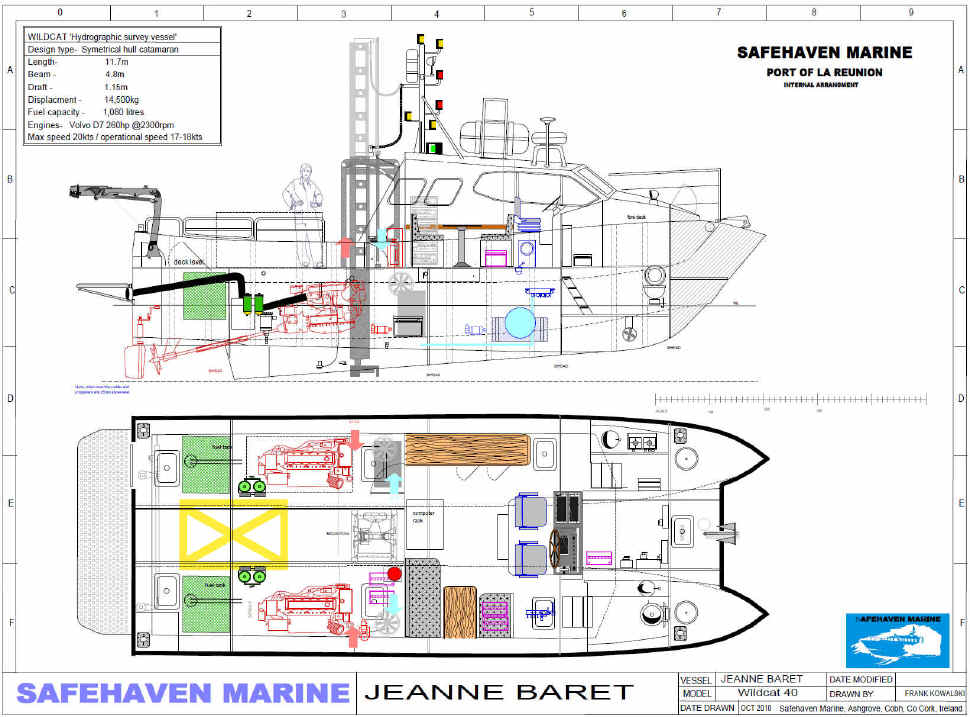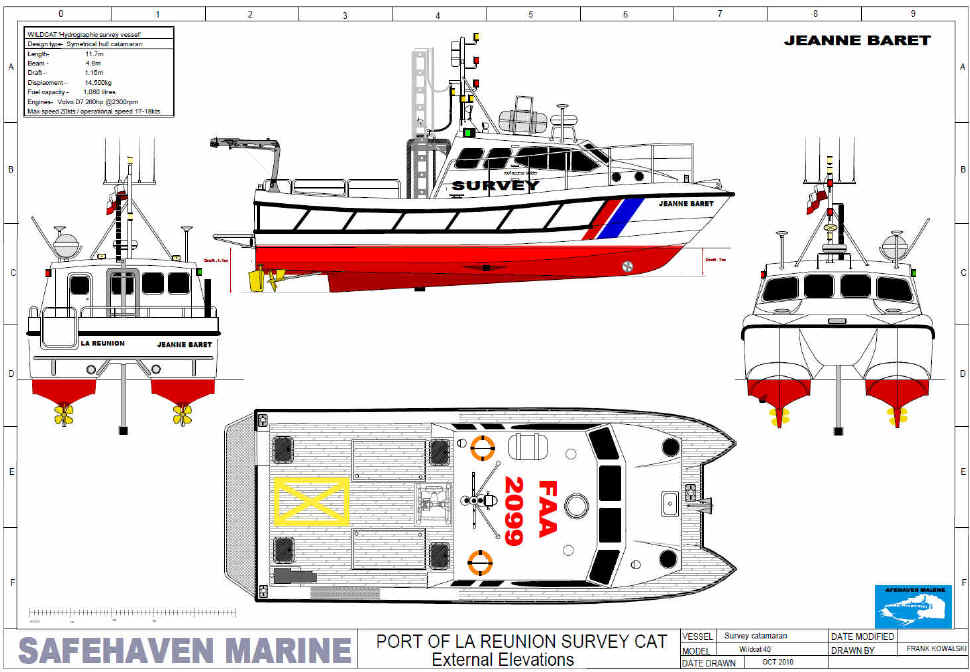| WILDCAT
40 / 12m HYDROGRAPHIC DESIGN
|
|||||
|
SPECIFICATION
L.O.A. Length Moulded BEAM Beam moulded Draft Displacment Lightship Seating capacity Fuel capacity Engines Power output Gearboxes Generator Speed Operational Maximum Certification
WLDCAT 40, Ocean Ranger in force 8 and breaking seas
Rough weather video of La Reunion Wildcat in big waves
WLDCAT 40, Seaflower Rough weather trials, force 7-8 off Cork, Ireland
WLDCAT 40, MISBEHAVIN. Rough weather video, twin boat, force 7-8
WLDCAT 40, BLACK cat. Rough weather trials, force 7-8 off Cork, Ireland
|
40ft / 12m 11.8m 4.9m 4.8m 1.3m
12,000-14,000kg 12 pass / 3 crew 1000 litres Volvo /Cat/Yanmar 250 - 500hp Twin Disc 5126 9kw
16-25kts 30kts+ MCA Bureau Veritas |
The WILDCAT 40 11.7m, high buoyancy, symmetrical hull catamaran, designed to offer a large stable work platform in an attractive, graceful design, combining style and good looks with practical functionality, a rare combination today. With a length overall of 12m / 40ft and a beam of 15ft the vessels hulls have been designed to provide high buoyancy in the fwd sections to prevent slamming on the bridge deck, which itself is raised as high as practical above the WL The hulls are designed to develop a spray cushion, softening the ride at speed. Full length keels are incorporated, and provide protection to the propellers, as well as increasing the hulls grip on the water for slow drift speeds. The vessels beam has been constrained to a wide 15ft 5" providing a good compromise between work area, stability, and minimal slamming that tends occurs on catamarans that have a very wide bridge deck. Also marina space and berthing facilities are considered, where excessive beam can be hard to facilitate. The superstructure design is full with maximizing internal accommodation area, yet providing a large and spacious flush aft deck, with the engines accessed from large opening flush hatches, providing excellent accessibility to the engines for service. The catamaran design has of course very high levels of survivability with 8 individual watertight compartments
Design features. The benefits of the
catamaran hull form are: Transverse static
stability, less rolling and motion Directional stability
in following sea conditions Lower vertical
accelerations smother motion in choppy head seas Lower power
requirements Greater economical
operational range Deck area Cabin space
Head sea abilities Due to the slender
nature of the hulls, in choppy conditions vertical accelerations are
much reduced in comparison with mono hulls giving a gentle ride and
motion. However previously
the biggest disadvantage of the older type of catamaran hull which
featured very fine sections fwd with little reserve buoyancy, giving a
very smooth ride in short sea states but suffering badly in ocean swell
conditions due to slamming on the bridge deck. This shortcoming has been
solved with much fuller fwd sections and much greater buoyancy, giving
the hull the necessary lift to prevent slamming on the bridge deck,
allowing higher speeds to be maintained into larger ocean swells. Performance Due to the low
resistance of the slender catamaran hulls, performance is excellent,
especially at moderate speeds up to 20kts. Typically, horse power
requirements are lower than in a similar sized mono hull. Furthermore
the flat running angles of the catamaran hulls, with no hump to overcome
means that there is a wide range of economical speeds, incurring no
penalty in fuel consumption at transition speeds often dictated by
weather conditions. Stability Probably the greatest
benefit of the catamaran hull form over the monohull is its transverse
static and dynamic stability. With GM figures typically 3-4 times
greater than a similar sized mono hull the operational envelope in rough
weather is extended. The Catamaran is able to provide a much more stable
work platform at rest than a monohull with greatly reduced rolling and
motion. In extreme conditions they are often the safest due to their
great transverse stability.
Safehaven Marine, Ashgrove, Cobh, Co Cork, Ireland Phone 00353 86 8054582 Email- info@safehavenmarine.com safehavenmarine@eircom.net
|
|||


